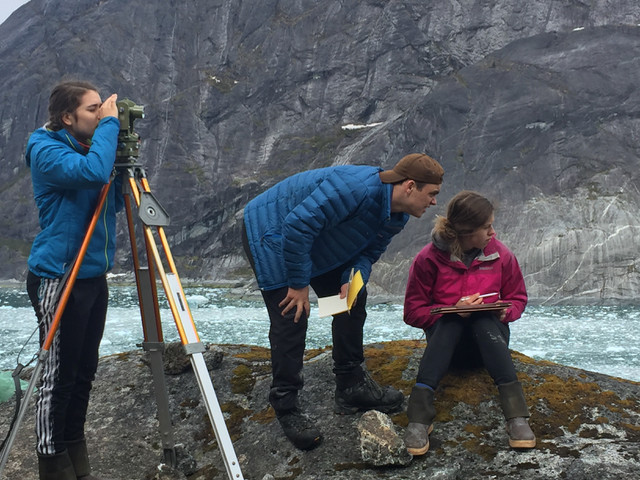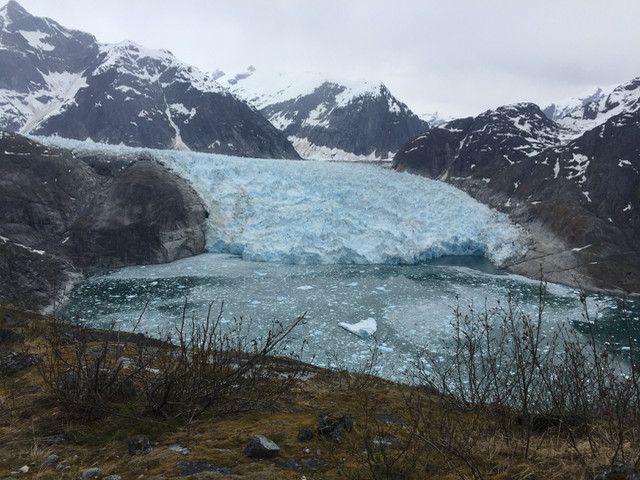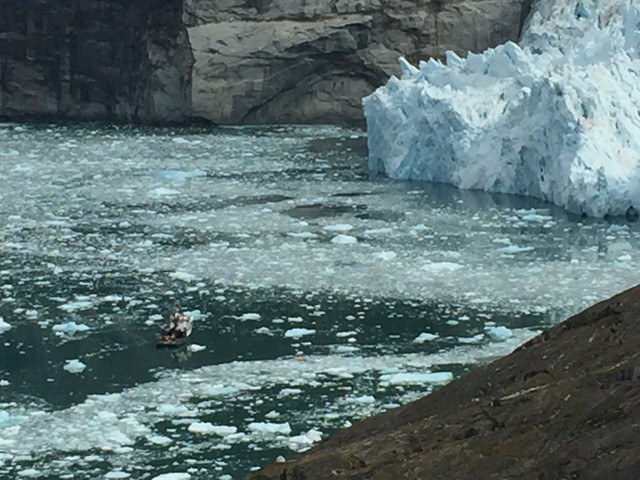
Mariah Taylor, Nathaniel Lenhard and Izabelle Ith survey LeConte Glacier May 11th. (Photo courtesy of Jon Kludt-Painter)
Students from Petersburg High School last month completed their annual survey of the position of the LeConte Glacier on the mainland near Petersburg. The southernmost tidewater glacier in the northern hemisphere has shown a little change since last year.
Audio PlayerTemsco helicopters transports two teams of high schoolers into position on the steep rock wall on both sides of mainland glacial fjord. Since 1983 students have been returning to those two survey markers fixed in the rock and taking readings on the position of the ice. The large ice mass is constantly moving, and breaking off large chunks into the water. Senior Nathaniel Lenhard says that made it challenging this year.
“Halfway through our point thing we were getting our points, we were looking for ‘em and maybe like about a fifth of the glacier kind of calved,” Lenhard explained. “So we lost about three of our points.”
Students in the program practice surveying during their lunch hour starting sophomore year. They typically go on the survey their junior and senior years, switching sides of the fjord. Also taking sightings with Lenhard this year were classmates Mariah Taylor and Izabelle Ith, and both were there for the second year. Ith calls it an amazing experience.
“It’s a beautiful spot,” she said. “You’re up on the rock and you’re kind of where, people don’t get this view of the glacier at all and to be able to get in a helicopter twice during your high school years is so cool and it’s beautiful. Both years we’ve had relatively good weather this year was a little cloudy but regardless it’s one of the most beautiful places I’ve ever been.”
The third member of that team, Taylor noted a difference from last year. “You could see that the glacier had like receded a lot,” she said. “We switched sides from last year so that was like a new experience and we could see the glacier from two different angles and you could tell like the different rivets better from one side than the other. And it was really fun.”
Prior students have documented some big retreats of the ice mass in the 1990s. Since then the springtime location of the glacier’s terminus has not shown big changes in its location, in a relatively narrow and shallow part of the fjord. Teacher Victor Trautman explained the glacier face is essentially where it has been for more than a decade. “Realize that the glacier is a dynamic moving object and right now when we were there it was at the furthest, probably about 200 feet behind where it has been laying for the last 10 years,” Trautman said.
Researchers expect the ice will have more big retreats in the future. LeConte is the subject of a multi-year joint research project into the interaction of the ice and the water of the fjord to better understand how those changes happen with a warming climate. The survey students were able to watch some of that other research.
Senior Emma Chase was on the north side this year. “We saw a little boat right in front of the glacier and they would take a kayak, a little drone kayak and go near the face of the glacier,” Chase said. “And then when we were completely done, the south side we looked through the theodolite and we looked up higher than the south side was and you could see the little camp that the glaciologists were on.”
On the north side the students wait for the other group to get their work done. That team then comes over to north side to tell which points on the face of the glacier to survey. Chase explained that can be tricky. “I think the hardest part was when the south side would come over and then we have to pick the points that they already shot. Definitely different because the perspectives on the glacier are different.”
Another teacher on the project, Jon Kludt-Painter said technology helped with identifying points on the ice. “One thing that we added is we brought in a larger iPad on the south side,” Kludt-Painter said. “And Izabelle, Mariah and Nathaniel were able to work around it’s a 12 inch screen with an Apple pencil and be able to pinpoint the marks and then go over to the north side. They’re able to, actually it speeds up the process quite a bit to have that digital reference. They’re able to, in the previous years they made sketches, so this is really advanced and have been able to make the points a lot more accurate.”
Another senior Alexandra Bless was also on the north side with Chase. “It was really nice to go a second year,” Bless said. “I enjoyed it a lot last year. But like Emma said we were on the south side last year and it was a lot more down time. But I feel sorry for the south side because it was probably a lot more windy. It was really nice last year but it was still windy on the south side. So it was probably a lot more difficult to do that this year.”
The students bring home their measurements and with the help of math teacher Tommy Thompson compute their angles and distances, plotting the latest position to go along with the calculations from the past 33 years. The annual helicopter visit to the Stikine-LeConte Wilderness is done under a special use permit issued by the U.S. Forest Service.
Teacher Jon Kludt-Painter produced a video of this year’s trip.












